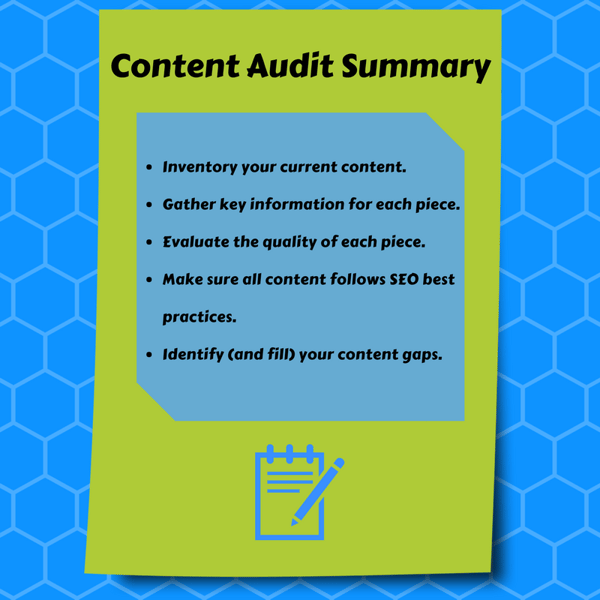Is your website bogged down by old or poor-quality content? It very well could be – but you might not know it.
Last week, we introduced readers to the concept of a content audit, which is designed to evaluate your website’s current content in order to maximize its quality and ramp up its SEO standing. We also discussed why these audits are an essential part of your content development plan.
Now that we’ve established the importance of a content audit, we’ll dig deeper into how content audits work with a detailed, five-step audit plan.

Step 1: Inventory your website’s existing content.
Start by compiling a list of every single piece of content on your website. Typically, this list is best suited for a spreadsheet, such as those offered by Google Docs or Microsoft Excel. Be sure to include both the URL and the title of the content, as well as where each piece is located within your website’s taxonomy, which will help to ensure that the content is located in the correct section of your website.
Building an inventory of your website’s content is fairly simple, but also quite time-consuming – particularly if you’re auditing your website for the first time.
Step 2: Identify major points and gather metrics for each piece of content.
Here’s where things get exciting. Once you’ve completed your inventory, it’s time to identify and list all of the information that’s relevant to each piece of content beyond its title and URL. Information typically considered essential to this step of the content audit includes:
- Topics/subjects/types of information contained within the content
- Ranked keywords
- Conversion rate
- Organic traffic
- Publish date
- Page speed
Excellent starting points for this step include Google Analytics and your content management system (CMS) of choice – but don’t hesitate to choose another analytical tool that best suits the needs of your website. Plus, bear in mind that the above information isn’t an exhaustive list of data that might come in handy during your audit, so be sure to collect any information that you feel will be helpful.
Step 3: Evaluate each piece of content based on quality.
Now, it’s time to read through each piece of content – yes, that means every single one – to determine whether it meets your company’s current standards. There’s a good chance that you’ll find content that’s simply not up to par. Some may have been poorly written, while other content may have simply been created before your company established its standards and refined its brand persona. And that’s fine – that’s why you’re conducting an audit in the first place.
Consider providing each piece of content with a score based on its quality – for example, 1 being extremely low-quality, versus a 10 for a perfect piece – so you know what needs to be improved once you’ve wrapped up your evaluations. Additionally, create a notes section within your content inventory where you can jot down quick details about the errors you find.
While you’re working through your quality appraisal, keep all of these questions in mind to help focus your evaluation efforts:
- Is the information correct, relevant and up-to-date?
- Are there spelling, grammar and/or punctuation errors?
- Is the writing style in line with your brand’s current persona?
- Does the content help your business achieve its goals?
- Does the piece provide value for its target audience?
Upon completion of your analysis, make sure to consider all of your options when implementing the necessary improvements. Outdated, irrelevant content can be removed completely, while other pieces may work best consolidated or updated. Still others could require only minor improvements – there’s no one-size-fits-all solution.
Step 4: Analyze content SEO.
By now, you should have a good idea of where your content stands in terms of quality, which leads directly to the fourth step of the content audit: addressing SEO. That’s because one of the primary factors behind your content’s SERP ranking is the quality and relevance of the content itself.
Exploring your content to ensure the presence of SEO best practices is a key step in any content audit, because it offers an opportunity to identify outdated SEO behaviors, which are fairly common thanks to the ever-changing nature of the SERP.
Things to examine for up-to-date SEO include:
- Keywords throughout the content itself
- Content comprehensiveness
- Page title
- URL
- Meta description
- Headings and subheadings
- Internal and external links
- Image titles and alt-tags
While you’re checking to make sure these components of your content are up to today’s standards, also be sure to look out for major issues that could be penalizing your content on the SERP. Common content problems could include any combination of the following:
- Irrelevant to the primary subject
- Poorly written (grammar errors, poor spelling, etc.)
- Too short to be genuinely helpful
- Duplicated from another part of your site or the web
- Poor keyword usage (keyword stuffing, etc.)
After making necessary SEO changes, keep a close eye on your website’s key performance indicators (KPIs) to ensure you made all of the right moves. Not seeing the improvements you hoped for? Adjust one element of your content at a time – headline, meta description, etc. – and see if it helps improve the piece’s SERP rank.
Step 5: Identify your website’s content gaps for future content development opportunities.
Congratulations! You’ve finished the section of the audit that tackles the content that’s already on your website. But there’s one last step that can help you make the most of this audit, and that’s determining which content your website should contain, but currently doesn’t.
Start by exploring the list of topics your existing content covers. Have you provided content that’s at least loosely related to every service your company provides? That would be a good start.
Then, compare your list with the content you find on blogs maintained by competing companies. Sift through several pages of these blogs to discover what they’re providing that your blog does not, and jot that down in a list, too. Finally, after improving your current content, incorporate these new topics or types of blogs into your content development strategy to boost your ability to claim the top spot.

Expand Your Digital Reach with Professional Blogging Services
Conducting a content audit might seem like a chore, but its benefits can mean the difference between lackluster blog performance and the top spot on the SERP.
If you’re interested in taking your blogging efforts to the next level, reach out to Virtucom Group today. Our team of writers will provide expertly crafted content carefully tailored to your brand’s voice and goals.






